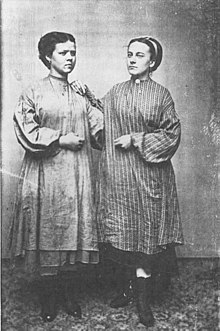
The Lowell mill girls were young female workers who came to work in textile mills in Lowell, Massachusetts during the Industrial Revolution in the United States. The workers initially recruited by the corporations were daughters of New England farmers, typically between the ages of 15 and 35.[1] By 1840, at the height of the Textile Revolution, the Lowell textile mills had recruited over 8,000 workers, with women making up nearly three-quarters of the mill workforce.
During the early period, women came to the mills for various reasons: to help a brother pay for college, for the educational opportunities offered in Lowell, or to earn supplemental income for the family. Francis Cabot Lowell emphasized the importance of providing housing and a form of education to mirror the boarding schools that were emerging in the 19th century. He also wanted to provide an environment that sharply contrasted the poor conditions of the British Mills notoriously portrayed by Dickens. Their wages were only half of what men were paid, yet many women were able to attain economic independence for the first time. The Lowell mill girls earned between three and four dollars per week. The cost of boarding ranged between seventy-five cents to $1.25, giving them the ability to acquire good clothes, books, and savings. The girls created book clubs and published journals such as the Lowell Offering, which provided a literary outlet with stories about life in the mills.
Yet through the Lowell Offering and other reports published around the time, it is demonstrated that the reality of working in the mills was not all rewarding. Though women gained economic independence, it came out various costs. The Lowell mill girls would work 12-14 hours a day in terrible conditions. The factories were dangerous and would put the girls health in jeopardy. Along with the factories being unsafe, the girls dormitories were crowded and unsanitary. While the factories had many dangerous aspects it is hard to view them as completely negative. Along with giving girls the opportunities for financial freedom it offered education. While working at the factories education was available to them, they could attend lectures, and they had access to a library. The Lowell did provide great inspiration and a beacon of what women can do, but it also had inhumane work conditions that countered the good it was doing. The Lowell provided When respected figures visited the mills, it was noted that the visitors only were presented with the nicely dressed operatives. What they visitors did not gain a glimpse of was the condition of most individuals working at the mills. Both the physical and mental state of workers were negatively impacted, representing the hidden dark realities of the mills. While the employers lived luxuriously, the workers faced an average working life of only three years. The Boston Quarterly Report of 1840 claims that workers were likely better off before beginning their labor at the mills than the condition that they developed during and after starting. Therefore, the poor conditions of those working the mills depict a contrasting mission that Francis Cabot Lowell claimed to pursue. Although he claimed to desire an improvement from the poor conditions of the British Mills, he may not have achieved that. Though women particularly were searching for economic freedom, the belief that their quest ended at the Lowell Mills may be contested. There may have been greater economic freedom then before, but it came at the costs of low wages to increase the economic wealth of their employers.[2]
Additionally, the women at the mills faced challenges regarding their new economic independence, as the low wages and great temptations to spend their little money kept them under bondage. The culture at the mills was often materialistic. With many shops enticing girls to purchase items and girls persuading each other, women at the mills still were not economically free. They continued to faced many voices on how to spend their money. Employers already gave them low wages. With the expectations to quickly spend their money, women have many external voices determining what enters and exits their wallets. Consequently, women at the mills are not reaching the economic freedom that they may have at first sought out for.[3]
Over time, adult women displaced child labor, which an increasing number of factory owners were disinclined to hire.[4] As the "factory system" matured, however, many women joined the broader American labor movement to protest increasingly harsh working conditions. Labor historian Philip Foner observed that "they succeeded in raising serious questions about woman’s so-called ‘place’."[5]
In 1845, after a number of protests and strikes, many operatives came together to form the Lowell Female Labor Reform Association, the first union of working women in the United States. The Association adopted a newspaper called the Voice of Industry, in which workers published sharp critiques of the new industrialism. The Voice stood in sharp contrast to other literary magazines published by female operatives.
- ^ Brooks, Rebecca Beatrice (25 January 2017). "What Was the Lowell System Used in the Lowell Mills?". History of Massachusetts Blog. Retrieved 27 January 2018.
- ^ The Laboring Classes an Article from the Boston Quarterly Review | Boston B.H. Greene| 1840| Accessed May 2024
- ^ title = Abby's Year in Lowell, The Lowell Offering| 1841 | E.T Hazeltine, Harvard University - Collection Development Department| Accessed May 2024
- ^ Bergquist, H. E. (January 1973). "The Boston Manufacturing Company and Anglo-American Relations 1807–1820". Business History. 15 (1): 45. doi:10.1080/00076797300000003.
- ^ "The Myth of the Mill Girls". The Attic. 30 August 2018. Retrieved 3 September 2018.
© MMXXIII Rich X Search. We shall prevail. All rights reserved. Rich X Search
